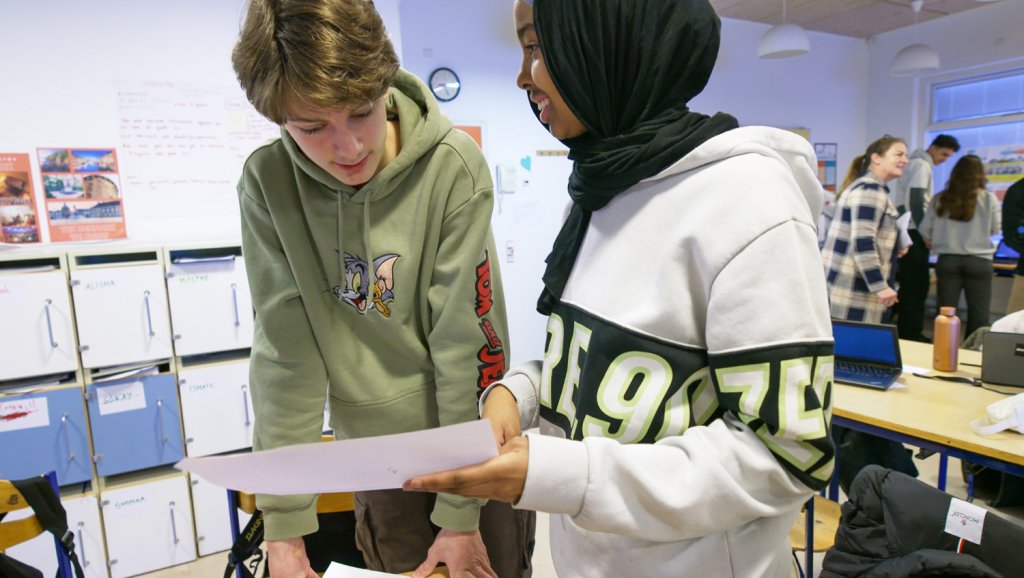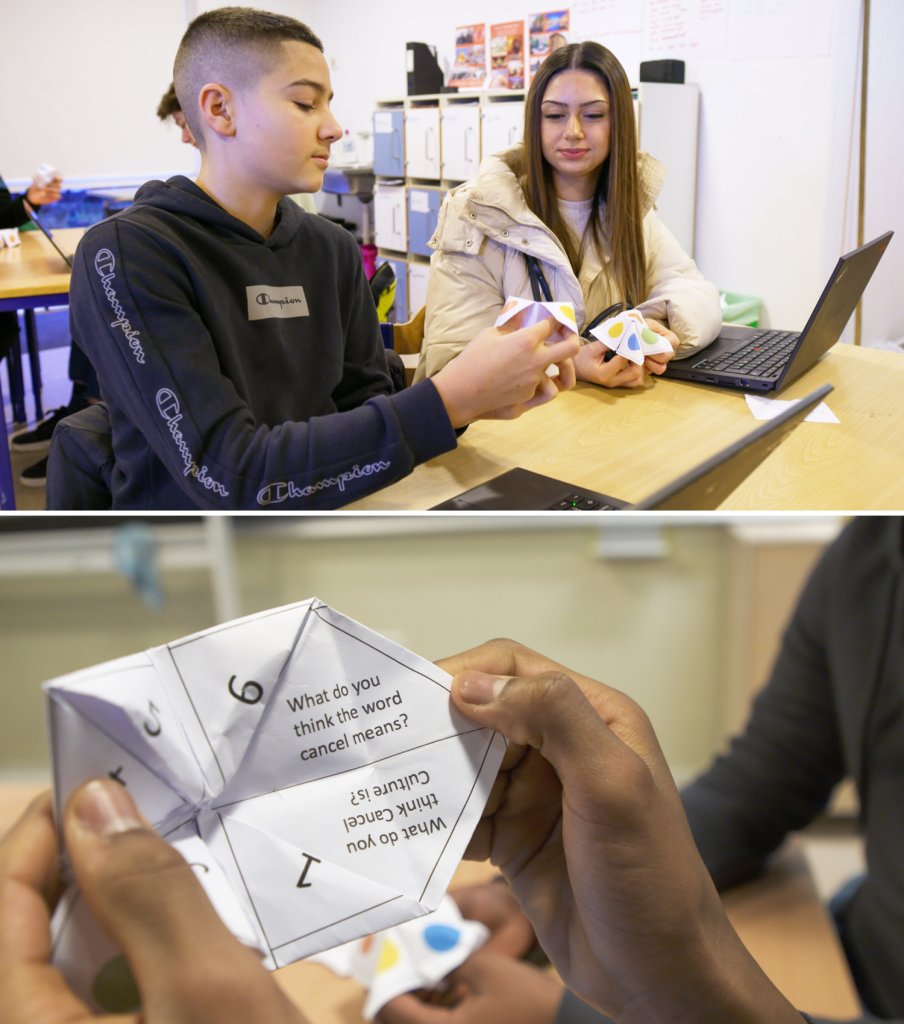17 Fun Games to Get World Language Learners Talking
When learning a new language, speaking in front of peers can be daunting. These games can help alleviate pressure and lower the stakes for students.
Speaking—it’s the main aspect of learning a new language that really intrigues students, writes former Spanish teacher Sarah Wike Loyola.
But even when students are offered opportunities to speak in the classroom, a room full of tweens and teens who were chattering away in the halls moments before will often fall completely silent.
“A student may have a deep fear of making a mistake, or may be just plain shy, even in their native language,” writes English as a second language tutor Diane Gantenhammer.
Games and playful activities are a great way to alleviate pressure, lower the stakes, and infuse joy and levity into what may be an anxiety-inducing process for some. Here is a list of 17 games to play with more advanced world language students (and, in some cases, even ELL students) that can help them use the new language they’re studying.

Sketch and Guess: Educator Fatima Belouahi secretly assigns each of her ninth-grade students a vocabulary term. She likes to tailor her choices where possible toward terms that may spark some interest, like free speech. Students draw a representation of their term, then walk around the room challenging classmates to identify what they’ve drawn. It has all the fun of Pictionary but with added academic benefits backed by research: When students draw information they’re learning, it can increase recall by nearly double.
Never Have I Ever: This classic game, often played at sleepovers, can take on a new life in the classroom. Kids start by holding five fingers in the air (use fewer if you’re short on time). Going around the room, each student will share something they’ve never done. For example, “Never have I ever traveled to another country.” All students who have traveled to another country put their finger down, then share a brief story related to that experience, writes Gantenhammer. Then the cycle restarts. Once a student has put down all of their fingers, they’re out.
Affirmative/Negative: Write a series of questions on the board that you might normally answer with a simple yes or no, like “Do you know how to make pancakes?,” “Can you ride a bike?,” or “Will you be taking the bus home from school today?” Next, let the class know that they cannot respond with yes or no, and that shaking their head or nodding doesn’t count either. Go around the room, asking each student to find a way to answer your question, and see what they come up with. (Sourced from Making English Fun.)
Who’s Telling the Truth?: On their own piece of paper, each student will write down their name and three facts about themselves that none of their classmates know. Choose three students to come to the front of the room, and choose one of the student’s facts to read aloud. Next, the investigation commences.
“All three claim that the fact is theirs, and the class then proceeds to question them in an attempt to determine who is telling the truth and who is lying,” Gantenhammer writes. Each student can pose one question to only one of the three students, then the class has to collaborate to figure out who is telling the truth.
Draw It Back to Me: In pairs, while one student covers their eyes with their hands, the other will draw a picture on a piece of paper. Simple imagery is ideal, like a flower or some fruit. Next, the artist will try to describe what the other student must now draw an exact replica of, but without showing the original sketch.
A student might instruct their partner to draw a strawberry cut into three pieces or a flower with five petals and a stem, but will the petals be the right shape? Will the stem be the right length? Should the flower be small, medium, or large? At the end, the pair can compare and contrast, discussing what they might’ve intentionally said instead to produce identical images and practicing their ability to be descriptive in their target language in the process. (Sourced from Making English Fun.)
Pick-a-Trait: This game works best a ways into the year when students have gotten to know each other, writes educator Susan Verner for Busy Teacher. In a hat or small bag, collect a bunch of slips of paper each listing a character trait like happy, funny, brave, and loyal. Have each student pick a trait out of the bag, select a student they think possesses that trait, and give an example of why. Students not only get to practice speaking but also can build stronger relationships with each other.
Guess The Secret Word: Start by assigning random topics and unrelated secret words to each student. For example, the topic could be “My favorite hobby” and the secret word could be “Pineapple.” The students’ mission? To stealthily embed their random word within a speech they’ll deliver to their peers without raising any suspicions as to what the word may be. The rest of the class become detectives, Gantenhammer writes, listening intently and then guessing the hidden piece of vocabulary.
The 5-Second Rule: This is a classic game of word association that will keep your class on their toes, writes Ewa Stoklosa, English language teaching content manager at ESL Brains. After receiving a category—like subjects in school or modes of transportation—a student has five seconds to brainstorm and shout out three related things that fall under that category. If they succeed, and the class decides their answers fit the category, they get a point. You can divide the class in half or into small groups, then see who gets the most points before a timer runs out.
Castaways: Each student starts by drawing an item—anything from an umbrella or a pizza to a bouquet of flowers. Encourage students to get creative, writes Gantenhammer. Collect the drawings, then pass them back out, ensuring that no student receives their own.
Next, tell the class that they are no longer students but castaways on a deserted island. On top of that, only half of them will be able to survive. All they have to their name is what is drawn on the piece of paper in front of them. Each student now has to justify their survival to their fellow islanders based on their item.
Can You Guess Who?: Compile the names of famous historical figures or celebrities in a hat. One student draws a name; then, with a partner, in small groups, or as a whole class, they’ll answer yes or no questions that help their peers guess their identity.
A fun riff on this activity starts with students putting a Post-it note on their forehead with a vocabulary word or tidbit of information on it—like an animal or a profession. Ensure that students cannot see what is written on their Post-it. Students then walk around the room asking questions of their classmates to find out who or what they are. (Sourced from Making English Fun.)
True or False: Randomly assign students to share a true story, or a completely fabricated story, with their classmates. One by one, they’ll take their place as storytellers, and afterward, classmates vote to determine their tale’s legitimacy. Gantenhammer suggests letting students question the storyteller for clues to extend the activity.
A Shared Story: Collaborative storytelling is a great way to help students practice speaking, listening, and building off the contributions of others, according to educators from Grand Canyon University. You can start the story off with a single line, have a student start, or even employ ChatGPT for a little inspiration. For example: At the stroke of midnight, a talking cat appeared outside Tim’s window, inviting him to a magical party that only animals knew about. From there, each student takes a turn adding another line to the story.
Coffeepot: This game is perfect for a class that needs a bit of extra practice with their grammar. Randomly select a student and assign them a verb, like dance. To guess the word, the class builds a body of clues based on questions they ask using the word coffeepot as a placeholder for the secret verb. For example, If it were raining outside, would you still coffeepot? Where are some places that are perfect locations to coffeepot? Are any celebrities good at coffeepotting?
“The verbs that work best in this game are those that refer to what people (or animals) do and that are intransitive (e.g., it is fairly easy to guess the verb swim but not necessarily the verb use),” writes Stoklosa.
Impromptu Improv: After brainstorming a bunch of different prompts for an interaction—like a host of a game show instructing a contestant or a detective interrogating a suspect—write them all down on slips of paper and put them into a hat. In pairs or small groups, have students pick out a scenario and play out the roles.
The activity could stop there, but in Belouahi’s classroom, students coauthor a script for the role-play, use arts and craft materials to make props, and film their scenes on their cell phones. The final product is seen only by the students and Belouahi, which alleviates some pressure and empowers students to take more risks as they grapple with vocabulary in unexpected ways.
Four Corners: At the 2022 Elementary and Secondary Education Act Conference (ESEA), Title 1 Academic Language Coach Amy Gilliam and her colleagues shared a variety of oral language protocols and collaboration activities that can help increase engagement. Four Corners is one of them.
This activity works best in a classroom where there’s room for students to freely walk back and forth. Designate each corner of the room with a letter: A, B, C, and D. Next, ask a multiple choice question, and have students walk to the corner of the room that reflects which answer they think is correct. With their fellow classmates who chose the same answer, the small groups will discuss why they think they’re right. Offer a little help by way of sentence starters where needed. In a whole class discussion, students can chime in and defend their decision before you reveal the correct answer.

Fortune Teller: Paper fortune tellers might be a nostalgic throwback for some students, but in this game they’re a quick way to spark deep and engaging conversations. The outermost flaps will be marked with colors, then numbers, while the innermost flaps conceal a question that students will discuss in the target language. During a lesson on social media and cancel culture, Belouahi’s students answered questions like “What is cancel culture?” and “How can someone behave badly online?”
In pairs, one student operates the fortune teller while the other student chooses a color and spells it aloud (“Green, G-R-E-E-N”), then a number (“Four, F-O-U-R”). They choose one more number, which determines the flap to lift and reveals the question that the pair will discuss. For free customizable templates, search online with the keywords “editable fortune teller template.”
First One, Then Many: Pass out index cards to each student in the class with an image, vocabulary word, or short phrase on them. Ask students to form small groups with peers who have a card connected to theirs. For example, a card with the word cow, another with a picture of a milk carton, and one with a picture of grass may form a group. The newly formed group should collaborate to come up with an explanation for why their cards are all linked and defend it to the teacher. (Sourced from Amy Gilliam, Angie Jones, Lara Randby, and Denise Zawada.)
